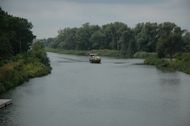Components and Algorithms
A detailed description of the components and algorithms implemented in WaSiM is deliberately omitted at this point. Please refer to the detailed WaSiM documentation.
| model component | Algorithm | |
| Precipitation correction | temperature and wind dependent correction after Sevruk (1986); Correction is done separately for rain and snow | |
| Interpolation of meteorologic input data | (1) inverse distance weighting (IDW) interpolation (2) altitude dependent regression, using externally preprocessed parameter files (3) combination of (1) und (2) (4) interpolation with Thiessen polygones (5) bilinear interpolation (6) bilinear interpolation of gradients/lapse rates and residuals (7) bi-cubic spline interpolation (8) bi-cubic spline interpolation of gradients/lapse rates and residuals (9) read grids according to the name in a grid list file (10) altitude dependent regression of Stationdata directly in WaSiM (like method 1) (11) regression and IDW from station data (equivalent to method 3 (12) Thiessen combined with given lapse rates | |
| Regional superposition | Allows application of different interpolation methods for different regions or different parameters for identical methods but different regions or even the application of multiple interpolation methods for the same region (with weighted superposition) | |
| Shading, slope and aspect dependent correction for direct radiation and temperature | Methods proposed in Oke (1987) and some internally developed algorithms (for T-correction) | |
| Evapotranspiration | (1) Penman-Monteith (Monteith & U., 1990), also for layered vegetation (2) approach after Wendling (1975) (3) approach after Hamon (1961) (4) approach after Haude (1955) | |
| Snow accumulation and melt | (1) temperature index method (degree day) (2) temperature wind index method (3) simple energy balance method (Anderson 1973) (4) extended energy balance method (Braun 1985) (5) Enhanced energy balance approach (enhEnbal) (with more sophisticated parameter estimations) (6) enhEnbal + gravitational slides (7) enhEnbal + gravitational slides + wind redistribution (8) T-Index + gravitational slides (9) T-Index + gravitational slides + wind redistribution (10) T-Index + wind redistribution (11) enhEnbal + wind redistribution (12) T-u-Index + gravitational slides (13) T-u-Index + wind redistribution (14) T-u-Index + gravitational slides + wind redistribution | |
| Layered snow model | Accumulation and melt are modelled in layers. Water fluxes in the layers is computed using the Richards approach by assuming the snow to be part of the soil (with special parameterization for snowy soil layers). This gives a big advantage for soil temperature modelling | |
| Glacier melt and glacier runoff | (1) temperature index method (2) approach after Hock (1999) with radiation impact | |
| Glacier dynamic | algorithms for growing or shrinking of glaciers (after Steel (2008)) are available in the dynamic glacier model. | |
| Interzeption | Integrated into multi layer vegetation model, either after (legacy) of before snow model (recommended, use methids 11 and higher); methods: [1] classic bucket apprach with EI taken as part from ETP, first snow model, then interception [2] classic bucket apprach with a separate EIP for generating EI, first snow model, then interception; [11] like 1 but first interception then snow model; [12] like 2 but first interception then snow model; [21]/[22] new canopy snow interception model for snowy conditions, else like 11/12; [31]/[32] additional canopy energy balance as en extension to 21/22; else for liquid storage same as 11/12 | |
| Dynamic phenology | dynamic computing of phenological phases by using one of four approaches (thermal time models and sequence models; also with regard to dormancy | |
| Runoff generation | (1) Topmodel approach after Beven and Kirkby (1979) (2) implicit runoff generation with Richards (1931) approach, see following components of soil water and groundwater dynamic | |
| Silting-up | using approaches that estimate the soil sealing dependent on soil grain sizes, kinetic energy of the rain, soil and crop type and other parameters | |
| Soil water dynamic | vertical water movement in the unsaturated zone of the soil based on the Richards-Equation (1931) with parameterization after van Genuchten (1980) | |
| Heat transfer | Finite Differences Method; implicit solution of the heat transport equation in the soil, 1D-vertical; Including advection (heat transport by infiltrating water), Regarding freezing up and thawing of the soil including the impacts on the hydraulic properties of the soil | |
| Groundwater dynamic | Finite differences method; iterative solution of flow and transport equation; consideration of multiple aquifers (confined and unconfined) | |
| Runoff concentration | (1) Single linear reservoir series considering translation times (translation-retention approach) (2) Kinematic wave apporoach for routing surface runoff from cell to cell, thus modelling runoff concentration for each sub basin physically based | |
| runoff channel routing | Kinematic wave approach (Lighthill & Witham, 1955) | |
| Tracer and substance transport | Consideration of conservative (non-radiactive) and radioactive tracers, volatile and non-volatile tracers as well as salts (which can even fall out); Calculation of (mixing-)concentrations in almost all sub models | |

![[D]](../../templates/images/logos/flag-de.png)
![[E]](../../templates/images/logos/flag-en.png)




